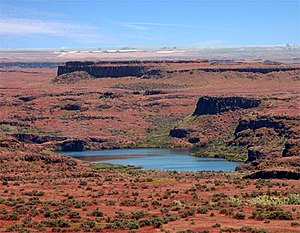Coulee
Coulee is a term that originates from the Canadian French word coulée, derived from the French word couler meaning "to flow". The term is used in different contexts within the field of geology and geography to describe a type of landform that is shaped by the action of water or glacial ice. Although coulees can be found in various parts of the world, they are most commonly associated with the landscapes of the Northwestern United States and the Canadian Prairies.
Definition and Characteristics[edit | edit source]
A coulee is a deep, steep-walled ravine or gulch, often dry, that has been carved into the landscape by the action of flowing water or by glacial meltwater. These landforms can vary greatly in size, from small gullies to large valleys. In regions affected by glaciation, coulees may also refer to a kind of glacial trough or a long, winding ridge known as a drumlin when formed by glacial action. The key characteristic that defines a coulee is its formation process, which involves erosion by water or ice rather than tectonic activity.
Geographical Distribution[edit | edit source]
Coulees are prominent features in the Channeled Scablands of the Northwestern United States, a region sculpted by the cataclysmic Missoula Floods that occurred at the end of the last Ice Age. These floods carved out a unique landscape of deep coulees, buttes, and plateaus. In Canada, the Canadian Prairies are home to numerous coulees, with some of the most notable examples found in the province of Alberta. These landforms play a significant role in the local ecosystems and water drainage systems.
Ecological and Human Impact[edit | edit source]
The unique topography of coulees influences local ecosystems by creating microhabitats with varying moisture and sunlight conditions. This diversity can support a wide range of plant and animal species. In agricultural regions, coulees may affect farming practices and land use, as their steep sides and potential for erosion can complicate access and cultivation. Additionally, coulees are significant in cultural and historical contexts, serving as landmarks and in some cases, as sites for human habitation and activity throughout history.
Conservation[edit | edit source]
The conservation of coulee environments is important for maintaining biodiversity, protecting water quality, and preserving the natural landscape. Efforts to conserve these areas may involve managing erosion, protecting against development, and maintaining the natural flow of water to ensure the health of these unique ecosystems.
Search WikiMD
Ad.Tired of being Overweight? Try W8MD's physician weight loss program.
Semaglutide (Ozempic / Wegovy and Tirzepatide (Mounjaro / Zepbound) available.
Advertise on WikiMD
|
WikiMD's Wellness Encyclopedia |
| Let Food Be Thy Medicine Medicine Thy Food - Hippocrates |
Translate this page: - East Asian
中文,
日本,
한국어,
South Asian
हिन्दी,
தமிழ்,
తెలుగు,
Urdu,
ಕನ್ನಡ,
Southeast Asian
Indonesian,
Vietnamese,
Thai,
မြန်မာဘာသာ,
বাংলা
European
español,
Deutsch,
français,
Greek,
português do Brasil,
polski,
română,
русский,
Nederlands,
norsk,
svenska,
suomi,
Italian
Middle Eastern & African
عربى,
Turkish,
Persian,
Hebrew,
Afrikaans,
isiZulu,
Kiswahili,
Other
Bulgarian,
Hungarian,
Czech,
Swedish,
മലയാളം,
मराठी,
ਪੰਜਾਬੀ,
ગુજરાતી,
Portuguese,
Ukrainian
Medical Disclaimer: WikiMD is not a substitute for professional medical advice. The information on WikiMD is provided as an information resource only, may be incorrect, outdated or misleading, and is not to be used or relied on for any diagnostic or treatment purposes. Please consult your health care provider before making any healthcare decisions or for guidance about a specific medical condition. WikiMD expressly disclaims responsibility, and shall have no liability, for any damages, loss, injury, or liability whatsoever suffered as a result of your reliance on the information contained in this site. By visiting this site you agree to the foregoing terms and conditions, which may from time to time be changed or supplemented by WikiMD. If you do not agree to the foregoing terms and conditions, you should not enter or use this site. See full disclaimer.
Credits:Most images are courtesy of Wikimedia commons, and templates Wikipedia, licensed under CC BY SA or similar.
Contributors: Prab R. Tumpati, MD




